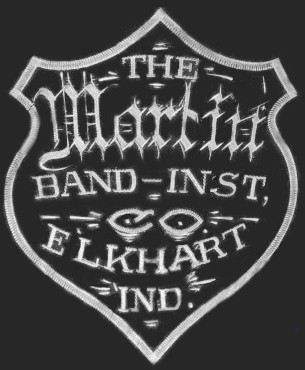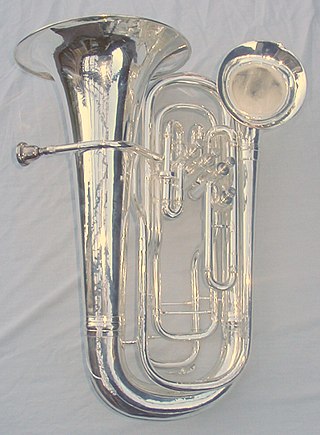Related Research Articles

The trombone is a musical instrument in the brass family. As with all brass instruments, sound is produced when the player's vibrating lips cause the air column inside the instrument to vibrate. Nearly all trombones use a telescoping slide mechanism to alter the pitch instead of the valves used by other brass instruments. The valve trombone is an exception, using three valves similar to those on a trumpet, and the superbone has valves and a slide.

The sousaphone is a brass musical instrument in the tuba family. Created around 1893 by J. W. Pepper at the direction of American bandleader John Philip Sousa, it was designed to be easier to play than the concert tuba while standing or marching, as well as to carry the sound of the instrument above the heads of the band. Like the tuba, sound is produced by moving air past the lips, causing them to vibrate or "buzz" into a large cupped mouthpiece. Unlike the tuba, the instrument is bent in a circle to fit around the body of the musician; it ends in a large, flaring bell that is pointed forward, projecting the sound ahead of the player. Because of the ease of carrying and the direction of sound, it is widely employed in marching bands, as well as various other musical genres. Sousaphones were originally made of brass. Beginning in the mid-20th century, some sousaphones have also been made of lighter materials such as fiberglass & plastic.

The valve trombone is a brass instrument in the trombone family that has a set of valves to vary the pitch instead of a slide. Although it has been built in sizes from alto to contrabass, it is the tenor valve trombone pitched in B♭ an octave lower than the trumpet which has seen the most widespread use. The most common models have three piston valves. They are found in jazz and popular music, as well as marching bands in Europe, where they are often built with rotary valves and were widely used in orchestras in the 19th century.

The superbone is a hybrid tenor trombone in B♭ that has both a slide like a regular trombone and a set of valves like a valve trombone.
C. G. Conn Ltd., Conn Instruments or commonly just Conn, is a former American manufacturer of musical instruments incorporated in 1915. It bought the production facilities owned by Charles Gerard Conn, a major figure in early manufacture of brasswinds and saxophones in the USA. Its early business was based primarily on brass instruments, which were manufactured in Elkhart, Indiana. During the 1950s the bulk of its sales revenue shifted to electric organs. In 1969 the company was sold in bankruptcy to the Crowell-Collier-MacMillan publishing company. Conn was divested of its Elkhart production facilities in 1970, leaving remaining production in satellite facilities and contractor sources.

The Vincent Bach Corporation is a US manufacturer of brass instruments that began early in the early Twentieth Century and still exists as a subsidiary of Conn-Selmer, a division of Steinway Musical Instruments. The company was founded in 1918 by Austrian-born trumpeter Vinzenz Schrottenbach.
Conn-Selmer, Inc. is an American manufacturer of musical instruments for concert bands, marching bands and orchestras. It is a wholly owned subsidiary of Steinway Musical Instruments and was formed in 2003 by combining the Steinway properties, The Selmer Company and United Musical Instruments.

The bass trombone is the bass instrument in the trombone family of brass instruments. Modern instruments are pitched in the same B♭ as the tenor trombone but with a larger bore, bell and mouthpiece to facilitate low register playing, and usually two valves to fill in the missing range immediately above the pedal tones.

Henri Selmer Paris is a French enterprise, manufacturer of musical instruments based at Mantes-la-Ville near Paris. Founded in 1885, it is known as a producer of professional-grade woodwind and brass instruments, especially saxophones, clarinets and trumpets. Henri Selmer Paris was family-owned until 2018, when it was sold to Argos-Wityu.

Holton is a brand owned by the Conn-Selmer division of Steinway Musical Instruments. The original business was a used instrument shop began in 1898 by American trombone player Frank Holton in Chicago, Illinois. The firm built brass instruments for ten years in Chicago, then in Elkhorn, Wisconsin from 1918 until 2008, when production of Holton-branded instruments moved to Eastlake, Ohio. The business remained independent until it was acquired by Leblanc in 1964. Leblanc was acquired by Conn-Selmer in 2004 and its properties became subsidiaries of Conn-Selmer.
The Buescher Band Instrument Company was a manufacturer of musical instruments in Elkhart, Indiana, from 1894 to 1963. The company was acquired by the H. & A. Selmer Company in 1963. Selmer retired the Buescher brand in 1983.

The Martin Band Instrument Company was a musical instrument manufacturer in Elkhart, Indiana. The firm produced band instruments, including trumpets, cornets, fluegelhorns, trombones, and saxophones from 1908 through the 1960s. The brand was acquired by the Leblanc Corporation in 1971 and discontinued in 2007 after Leblanc's 2004 acquisition by Conn-Selmer.

The double bell euphonium is a duplex instrument based on the euphonium. The larger bell produces the mellow tone of a standard euphonium; the second smaller bell has a brighter tone, similar to a baritone horn or valve trombone. The instrument is sometimes dismissed as a novelty, but has had some enthusiastic adherents, including few professional musicians using it as their sole or primary instrument. The smaller bell can give more appropriate tone in the higher range of the instrument. The two bells can also be used for special effects, such as echoes, and using the distinctly different tone of the two bells for a single musician to give the effect of call and response.
Leblanc, Inc. was a musical instruments manufacturing company based in Kenosha, Wisconsin. The company was a woodwind instrument manufacturer known mainly for its clarinets. In 2004 the firm was sold to Conn-Selmer, a division of Steinway Musical Instruments. As a result, Leblanc ceased to exist as an independent operation, becoming a brand.
Steinway Musical Instruments, Inc. is a worldwide musical instrument manufacturing and marketing conglomerate, based in Astoria, New York, the United States. It was formed in a 1995 merger between the Selmer Industries and Steinway Musical Properties, the parent company of Steinway & Sons piano manufacturers. From 1996 to 2013, Steinway Musical Instruments was traded at the New York Stock Exchange (NYSE) under the abbreviation LVB, for Ludwig van Beethoven. It was acquired by the Paulson & Co. private capital firm in 2013.

The contrabass trombone is the lowest-pitched instrument in the trombone family of brass instruments. While modern instruments are pitched in 12 ft F with a single slide, the first practical contrabass trombones appeared in the mid-19th century built in 18′ B♭ an octave below the tenor trombone with a double slide. German opera composer Richard Wagner notably called for this instrument in his Der Ring des Nibelungen opera cycle in the 1870s, and contrabass trombone has since appeared occasionally in large orchestral works without becoming a permanent member of the modern orchestra.

King Musical Instruments is a former musical instrument manufacturing company located in Cleveland, Ohio, that used the trade name King for its instruments. In 1965 the company was acquired by the Seeburg Corporation of Eastlake, Ohio, and the name changed to "King Musical Instruments".
The trombonium is a brass instrument formerly manufactured by H.N. White Company and Conn-Selmer. It's essentially an Upright Valve trombone. It was unveiled by H.N. White in 1938 and was manufactured until the mid 1970s. The trombonium has the same timbre as a regular trombone except in a smaller, more compact form. It was originally designed to be used as a marching trombone, and has valves rather than a slide thus superficially resembles a tenor horn or euphonium. It was used by the University of Southern California Marching Band and on a handful of jazz recordings.

The soprano trombone is the soprano instrument in the trombone family of brass instruments, pitched in B♭ an octave above the tenor trombone. As the bore, bell and mouthpiece are similar to the B♭ trumpet, it tends to be played by trumpet players rather than trombonists. Compared to tenor, bass, or even uncommon alto, the soprano is a rare trombone. Seldom used in classical music since its first known appearance in 1677, it survived principally in the trombone ensembles of Moravian Church music. During the 20th century some soprano trombones—dubbed slide cornets—were made as novelties or for use by jazz trumpet players including Louis Armstrong and Dizzy Gillespie. A small number of contemporary proponents of the instrument include jazz artists Wycliffe Gordon and Christian Scott, and classical trumpeter Torbjörn Hultmark, who advocates for its use as an instrument for young children to learn the trombone.
References
- ↑ "King Model 2103 Straight Tenor Trombone". Conn-Selmer, Inc. 2012. Archived from the original on 15 May 2011. Retrieved 23 March 2012.
- ↑ "Edna White "The First Woman of Brass"" . Retrieved 23 March 2012.
- ↑ "H N White Trombones "The Acknowledged Standard"" . Retrieved 23 March 2012.
- ↑ "Encyclopeida of Cleveland History:King Musical Instruments" . Retrieved 23 March 2012.
- ↑ "Conn-Selmer, Inc Company History" . Retrieved 23 March 2012.